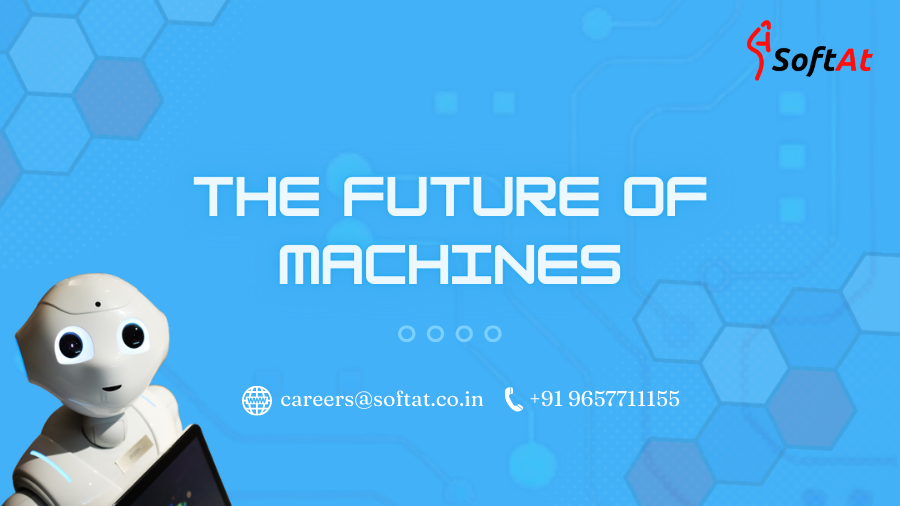With the rapid advancements in technology, the future of machines is rapidly changing. From artificial intelligence and robotics to machine learning and deep learning, the potential for machines to impact our daily lives is immense. In this blog, we will discuss some of the key trends and predictions for the future of machines and their potential impact on society.
AI is rapidly advancing and becoming more integrated into our daily lives.
AI is being used in a variety of applications, including virtual assistants, chatbots, and self-driving cars.
Predicted future developments in AI include increased automation, improved natural language processing, and the development of more advanced cognitive systems.
have you interested in SAP courses? then click here…
The specialists anticipated that organized man-made consciousness will enhance human viability yet in addition undermine human independence, office, and abilities. They talked about the boundless conceivable outcomes; that PCs could match or try and surpass human knowledge and capacities on errands, for example, complex independent direction, thinking and learning, modern examination and example acknowledgment, visual sharpness, discourse acknowledgment, and language interpretation. They said “shrewd” frameworks in networks, in vehicles, structures, and utilities, on ranches, and in business, cycles will save time, cash, and lives and proposition open doors for people to partake in a more-tweaked Future of Machines.
Robotics is becoming increasingly popular, and robots are being used in a wide range of industries, including manufacturing, healthcare, and retail.
The future of robotics is likely to involve the development of more advanced robots that can work alongside humans, as well as the integration of AI into robotics systems.
Predictions for the future of robotics include the development of robots with more advanced sensory systems, the ability to work in hazardous environments, and the development of robots that can perform a wider range of tasks.
- Machine Learning
Machine learning is a subset of AI that involves the development of algorithms that allow computers to learn from data.
Machine learning is already being used in a variety of applications, including image and speech recognition, natural language processing, and personalized recommendations.
Predicted future developments in machine learning include the development of more advanced algorithms, increased automation, and the integration of machine learning into a wider range of applications.
Deep learning is a subset of machine learning that involves the use of neural networks to perform complex tasks.
Deep learning is already being used in a variety of applications, including image and speech recognition, natural language processing, and self-driving cars.
Predicted future developments in deep learning include the development of more advanced neural networks, the integration of deep learning into a wider range of applications, and the development of more powerful hardware to support deep learning.
The future of machines is likely to be marked by increased automation, the integration of AI and robotics into a wider range of applications, and the development of more advanced cognitive systems. As machines become more advanced, they are likely to play an increasingly important role in our daily lives, and their impact on society is likely to be both positive and negative. On the positive side, machines can help to automate tedious and repetitive tasks, freeing up time for humans to focus on more creative and meaningful work. Additionally, machines can help to improve the accuracy and efficiency of decision-making processes, leading to better outcomes for individuals and organizations alike.
However, there are also potential downsides to the increased use of machines. For example, the automation of certain jobs may lead to job loss, and there are also concerns about the impact of machines on privacy and security. Additionally, there are ethical questions surrounding the development and use of machines, such as the responsibility of developers and manufacturers for the actions of machines and the potential for machines to be used for malicious purposes.
What is the future prediction of robots?
- Increased Adoption in Industries: Robots are already being used extensively in manufacturing and industrial settings. In the future, we can expect to see robots being deployed in even more industries, such as healthcare, logistics, agriculture, construction, and service sectors, to improve efficiency and productivity.
- Advancements in AI and Machine Learning: Artificial Intelligence (AI) and Machine Learning (ML) are playing a crucial role in making robots more intelligent and capable of learning from their experiences. This trend is expected to continue, leading to robots that can adapt and perform more complex tasks autonomously.
- Robotics in Healthcare: Robots are likely to find more applications in the healthcare industry, assisting with tasks like surgery, rehabilitation, patient care, and drug delivery. These robots could help in improving medical outcomes and easing the workload of healthcare professionals.
- Personal and Companion Robots: The development of personal and companion robots is an area of interest. These robots could provide companionship to the elderly or individuals with disabilities, assist with daily tasks, and offer emotional support.
- Autonomous Vehicles and Drones: Robotics is already revolutionizing the automotive industry with the development of autonomous vehicles. Similarly, drones are becoming increasingly popular for delivery, surveillance, and mapping purposes. The future may see widespread adoption of these technologies in various sectors.
- Ethics and Regulation: As robots become more advanced and autonomous, ethical considerations and regulations will become increasingly important. Discussions on the use of robots, their impact on jobs, safety, and privacy will be central in shaping future policies.
- Collaboration with Humans: Collaborative robots (cobots) are designed to work alongside humans safely and efficiently. In the future, we can expect to see more robots that augment human capabilities, leading to increased collaboration between humans and robots in various domains.
- Nanorobotics and Medical Applications: Advancements in nanorobotics could lead to minuscule robots capable of performing medical tasks at the cellular level. These nanobots could revolutionize drug delivery, disease diagnosis, and treatment.
It’s important to note that with any technological advancement, there are potential challenges and risks. Concerns about job displacement, ethical dilemmas, cybersecurity, and misuse of robotics technology will need to be addressed as the field progresses.
While we cannot predict the future with certainty, the robotics industry is continually evolving and holds the potential to significantly impact various aspects of our lives, making it an exciting area to watch and explore.
- conclusion
In conclusion, the future of machines promises to be an exciting and transformative period in human history. As the pace of technological advancement accelerates, we can expect to see a wide range of new machines and technologies that will fundamentally change the way we live and work. Key trends such as automation, artificial intelligence, and the Internet of Things will continue to shape the landscape of industry, healthcare, transportation, and many other areas of society.
Ultimately, the future of machines will be shaped not just by technological innovation, but by the decisions and actions of the humans who create and use them. By working together to anticipate and manage the risks and opportunities of this new era, we can ensure that machines serve the greater good and contribute to a more sustainable and equitable future for all.





